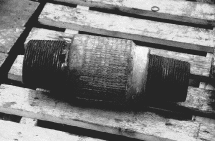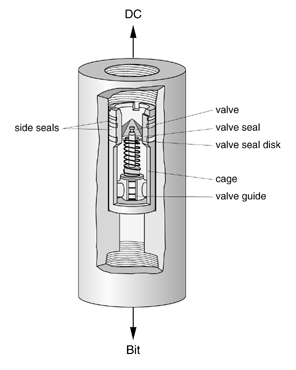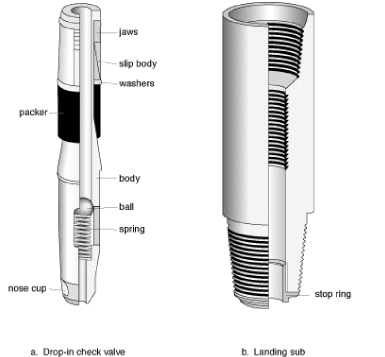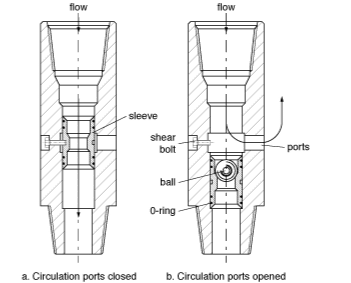Subs are short pieces of tubular material used to increase the versatility of the main component of the drilling string. The simplest is a crossover sub, which connects two items with different threads. Others used in the drill string are:
- float sub
- dart sub
- circulating sub
- bent sub
- Bit sub
- Orientating sub
- Totco ring
- Side entry sub
- Bumper sub (Check the previous article)
- Shock sub (Check the previous article)
Crossover Drilling Sub
These are short sections of drill collar material 0.6 m (2 ft) or longer, which provide crossovers between different diameters and types of the threaded connection.
They are configured with the following connections; box/box, pin/pin, pin/box, and box/pin subs.
It may not be evident that due to the way the thread is cut onto connections, a box/pin cannot be used upside down to form a pin/box!
Because subs have two connections close to each other, the string is locally weakened compared to the rest. This is particularly significant when heavy bending stresses are acting on the subs. We should pay particular attention to rig floor inspection of subs, which should be thoroughly inspected regularly.

Float Sub In Drilling String
A float sub is a non-return valve run just above the bit. One of its functions is to prevent the back-flow of drilling fluid into the drill string & Bottom Hole Assembly. This can occur when cuttings increase the effective density of the drilling fluid in the annulus and may result in the bit nozzles being plugged by cuttings. This problem is prevalent when drilling top hole sections because of the large cuttings produced at high penetration rates.
Another reason for running a float sub is to prevent the possibility of a blowout through the string. In the top hole, high-volume swabbing can rapidly lower the fluid level in the string due to the significant difference between the string and hole capacities.
When tripping in a string with a float sub installed, We must fill up the string while running in. If an empty pipe is suddenly filled by the annulus (failure of the valve), this could cause a significant drop of the head in the open hole and possibly cause a kick. A float sub in the string increases the surge pressures created while running in.

Drilling Dart Sub
The dart sub (You might be interested in: Inside BOP (IBOP), Kelly Valves Full Guide) is a landing sub for a drop-in and pump-down back pressure valve. Its function is to prevent a wells kick through the drill string in the same way as a float sub. The landing sub is installed near the drill collars. This gives the driller a means to land the valve before pulling out. The valve is pumped into the sub and will latch in place automatically. Dart subs of various types are often referred to HDIS as one of the leading manufacturers of darts subs. HDIS stands for Hydril Drop In Sub.

Circulating Sub
If required, the circulating sub can be incorporated into the drill string and operated while drilling to provide a large opening to circulate through. When drilling with a directional BHA Types, it is run directly above the Measurement While Drilling sub or down-hole motor; rotary drilling runs directly above the bit sub.

There are two principal reasons for using a circulating sub.
- When lost circulation material is pumped through the string, it could plug up the small nozzles in the bit or jam the inside of a turbine. We could use a circulating sub in the string to circulate the coarse material.
- To allow increased circulation rates for hole cleaning before pulling out of the hole.
To operate the sub, a ball is dropped down the drill string. The ball will sit on the sleeve and seal off the fluid flow. The shear bolt will break when the fluid pressure increases to approximately 20,000 kPa (3,000 psi). The ball and sleeve will then be forced downwards and uncover the fluid ports. The drilling fluid flow will then effectively bypass everything below the circulating sub.
After using a conventional circulation sub will have to be pulled to recover the ball and re-set the sleeve. A different type of circulating sub is now available to avoid this problem. One ball is dropped to open the sub, and a second is dropped to close it. This cycle can be repeated a few times until the ball catcher, installed below the sub, is full.
Drilling Bent Sub
A bent sub is made to have one tool joint set at a pre-determined offset angle, thereby creating a bend in the drill string, allowing the deflection tool to be faced in a certain direction for directional wells and sidetracking applications. Oil and Gas Manufacturers can supply bent subs with angles of 1° – 3º in 1/2º increments. The angle (1º – 3º ) can be positioned in a pre-determined direction, thus giving a directional BHA (a BHA designed to drill in a particular direction).
Generally, the bent sub is part of a non-rotating drilling assembly (Check also: Steerable Assembly, RSS In Drilling & Downhole Mud Motors). We will carefully consider the effects of fatigue before the string is rotated while it contains a bent sub.
The bent sub includes a mule shoe sleeve with an alignment key to orient the mule shoe of a survey tool barrel. The mule shoe sleeve is installed inside the bent sub and is lined up with the tool face using the orienting wrench before being secured in the sub by Allen screws.
When the survey tools are run in the hole, the mule shoe assembly will lock inside the sleeve, creating a positive positioning of the survey equipment. Alternatively, a UBHO (Orienting Sub) can be used.
Orienting Sub In Drilling
This sub is used in a directional drilling assembly to align the survey equipment with the deflection tool, as described in the previous paragraphs. This is done so that the path of the well can be recorded and observed.
The orienting sub is usually straight and often called a UBHO, “universal bottom hole orienting” sub.
In some cases, the orienting sub is combined with a bent sub. NOTE: All special-purpose BHA components above the UBHO sub with a restricted inside diameter (e.g., jars) should be replaced with ones with an appropriate inside diameter or removed to allow passage of the instrument barrel.
TOTCO Ring
A Totco ring is not a sub but is included here for convenience. A small insert is placed inside the drill string between a pin and a box connection. It does not interfere with the connection. It does not significantly restrict the fluid flow down the string, but it acts as a trap for survey tools that are dropped from the surface and retrieved later when the string is removed from the hole.

Side Entry Sub
Sometimes when we cannot log in using the traditional wireline unit, we may need assistance from the side entry sub. Its main application is to allow the passage of the wireline inside the drill pipes or tubing we are using while logging or even while fishing operations. This will provide a firm grip for the cable, which is subsequently pumped down and connected to the logging tool string.

Kelly Saver Sub
The major application of the Kelly saver subs is to protect the lower kelly connection from wear. This wear results from making and breaking the drill pipe connection while drilling. In addition, they will protect the top casing joint against excessive wear if fitted with a rubber protector and provide an area to tong on when working with the kelly.

Source link
#Drilling #Subs #Types #Applications